Bulls & Bears Collide In Crypto-Land: Hot-Hands Versus HODLers
Bears are on the hunt for Bitcoin HODLers profits, whilst supply dynamics approach a new equilibrium, and derivative markets remain heated...
Amid the "fear and panic" in the crypto markets, as Bitcoin drops 50% from all-time-highs, Glassnode.com's 'Permabull Nino' details the current uncertainty that overhangs the Bitcoin market, and the psychology of its participants attempting to regain their footing in the following areas:
-
HODLer profits sitting at key historical levels, and the overall observable investor response
-
Zoomed out supply dynamics and spending behavior among short-term and long-term holders, and what it indicates about investor sentiment in the medium to long term
-
Derivative activity, and what it can imply about shorter term expectations towards Bitcoin price action
HODLers Profits Under Siege
The Bitcoin price is currently trading down ~50% from the ATH set in November 2021. As the drawdown worsens, an increasingly significant volume of BTC supply has fallen into an unrealized loss. Approximately 5.7 million BTC are now underwater (~30% of circulating supply).
As the bears apply pressure to the in-profit cohort of holders, Bitcoin bulls are defending a historically significant level of the Percent of Supply in Profit metric. This magnitude of 'top heavy supply' was defended in two instances in the last few years:
-
May 2020 - July 2020, the quiet recovery period following the extreme move downwards from Covid-related panic.
-
May 2021 - July 2021, the choppy and accumulative period following a historical deleveraging event.
The reaction from this level will likely provide insight into the medium term direction of the Bitcoin market. Further weakness may motivate these underwater sellers to finally capitulate, whereas a strong bullish impulse may offer much needed psychological relief, and put more coins back into an unrealized profit.
We can establish an appreciation of market-wide psychology by observing who is parting ways with their coins, and why and when these spends are taking place. The Percent of Transfer Volume in Profit chart displays the proportion of coins spent on-chain that were last moved at lower prices, as a gauge for macro fear and greed.
-
Percent of Transfer Volume in Profit > 65% signals that a large amount of coins are being spent in profit. This historically occurs during bullish impulses, as holders take advantage of market strength.
-
Percent of Transfer Volume in Profit < 40% signals that on-chain volumes are dominated by coins acquired at higher prices. This historically occurs in market downtrends and especially capitulation events.
The sell-off this week saw less than 40% of spent volume in profit, reaching levels that historically coincide with capitulation events. Past instances at this level have preceded a bullish reversal, and a period of general risk-on behaviour.
The low levels of profitable coin spends is also evident in the Realized Profit chart, which shows the profitability of BTC moved, on a USD basis. In-profit holders are displaying a notable unwillingness to spend coins, with consistent Realized Profit values below $1 Billion/day. In the face of tumultuous and unconvincing price action, this signals that this cohort of holders are patiently waiting for higher prices to spend their respective supply.
Climbing realized profits, especially above the $1 Billion level and accompanied by positive price performance, signals demand absorption of coins, and is a metric to watch in the coming weeks.
Meanwhile, Realized Losses remain elevated and trending higher, as underwater holders spend coins that were acquired near the market top through October and November.
On average, daily Realized Loss values are ~$750 Million/day, behavior that is comparable to the May - July 2021 capitulation lows. The consistency of large loss realization events is indicative of uneasiness within the market, however also reflects an estimate of demand inflows to absorb these spent coins.
Sustained periods of large realized loss does put the onus on the bulls to prove sufficient demand support. A macro decline in realized loss values would be a more encouraging signal for the bulls, as it provides an early indication of sell-side exhaustion.
The stalemate at play between price action, Realized Profits, and Realized Losses is visible in the 28-day Market Realized Gradient (MRG), which compares the momentum in Market Cap (speculative value) versus the Realized Cap (real capital inflows).
-
Positive values signal that a bull trend is in tact, and upwards momentum in spot markets is growing.
-
Negative values signal that a bear trend is in play, and momentum favors the bears.
-
Large values signal that Bitcoin is possibly overbought (positive) or oversold (negative), as market valuation deviates from more fundamental capital inflows or outflows, respectively.
The MRG trend and values indicate that current market pricing is nearing a point of equilibrium with capital inflows, with a month's long bullish divergence developing. A firm break above zero would signal a bullish reversal is in play, whilst a break down would suggest momentum is accelerating to the downside.
Cohorts and Psychology
We can also analyse the psychology and spending behaviour of both Short-Term Holders (STH) and Long-Term Holders (LTH) by looking at changes in their respective Realized Caps and supply dynamics.
The following metric is calculated as the difference between the daily change of LTH and STH realized caps. Interpretation is as follows:
-
Negative Values (red) signal that the STH Realized Cap is increasing more on a daily basis than the LTH Realized Cap. This occurs during bull runs when long term holders distribute supply into new holders.
-
Positive Values (green) signal that the LTH Realized Cap is increasing more on a daily basis than the STH Realized Cap, which occurs during bearish accumulation markets as STH activity decreases, and unspent coins mature into the LTH cohort.
Values currently sit near zero with a general trend to the upside, indicative of a softening of distribution by LTHs, the market reaching a new equilibrium, and a potential reversal into accumulation. Note however, that the process of establishing similar market equilibrium and possible macro bottoms has historically taken several months to resolve.
The modest distribution of coins from LTHs to STHs is reflected in the Total Supply Held metric, as the net volume of coins held by the STH cohort has increased in recent months.
The supply held by this cohort sits at ~3 Million BTC, a relative historical low, and a level that signifies a transition into a HODLer dominated market. This has been in effect since the May 2021 deleveraging event. Low STH supply levels are typical of bearish trends, as old coins remain dormant, and younger coins are slowly accumulated by high conviction buyers.
Next we turn to the Realized Cap HODL Waves, which reflects the breakdown of the Realized Cap by coin age, and cost basis. The chart below has been filtered for coins younger than 3 months to further highlight the forces at play within the shorter term holder cohort.
Generally speaking, lower values in this metric speak to a bearish trend where old coins are dormant, and young coins are gradually accumulated and taken off market.
At present, around 40% of the Realized Cap is held in coins under 3mths old, owned by buyers entering near the market top, or during the present correction. The 1-3m band is expanding and a constructive view would see these coins continue to mature into the 3m+ band, creating a net decline in young coins. A more bearish observation would be if older coins start being spent, causing these bands to swell, and signifying an additional influx of liquid supply that must be absorbed.
Derivatives Fireworks on the Horizon
Amidst downwards pressure in Bitcoin holder profitability but yet favorable medium to long term supply dynamics, futures markets remain a powder keg for short term volatility with Perpetual Futures Open Interest at ~250k BTC - a historically elevated level.
Since April 2021, this has paired with large pivots in price action as the risk for a short or long squeeze increases, resolved in market wide deleveraging events.
Alongside high open interest, funding rates this week moved into negative territory, indicating that shorts were increasingly hungry for leverage. As perpetual swap markets were pushed below spot prices, it does add further bias towards a potential oversupply of short positions in close proximity to the current price.
In addition to large outstanding open interest, and negative funding rates, trading volume continues to drip lower, currently around $30B per day. This is coincident with levels in December 2020, and reflects a marked reduction from the 2021 bull market highs, hitting well above $70B/day. Should a deleveraging event occur, thinner trading volumes may accentuate the impact.
As Open Interest continues charging for a big move, funding rates drop, and futures volumes contract, Crypto-Margined Open Interest continues its march downwards versus Cash-Margined Open Interest.
With only 40% of Open Interest sitting in Crypto-Margined products and in a convincing downtrend since May 2021, Cash-Margined Futures data becomes increasingly higher signal and worthy of more market participants' attention. Note that this trend is primarily driven by a relative reduction in crypto-margin on Binance, Bybit, Huobi and OKEx exchanges.
In summary, there is evidence that the market is reaching some form of price and momentum equilibrium, within what is a broader bearish market structure. Bitcoin bears certainly have the upper hand, however modest bullish divergences are appearing across a number of on-chain metrics and indicators. Coupled with elevated future open interest, and a bias that appears to be a short heavy market, a risk of a deleveraging to the upside remains on the table.
https://ift.tt/3GTqegN
from ZeroHedge News https://ift.tt/3GTqegN
via IFTTT




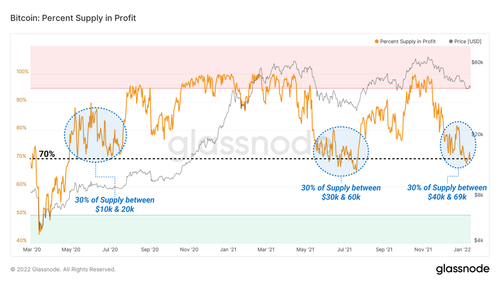
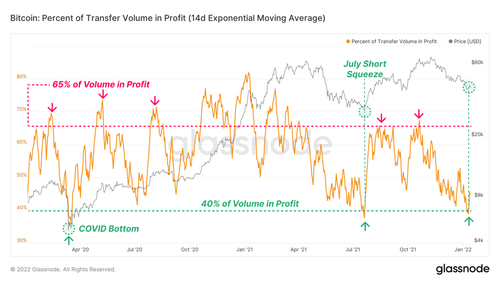


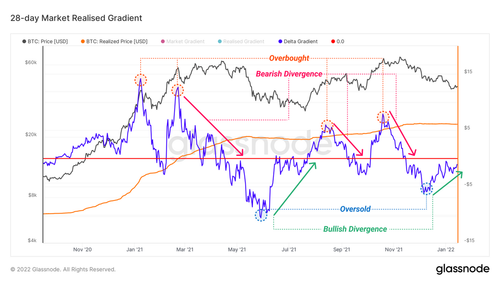

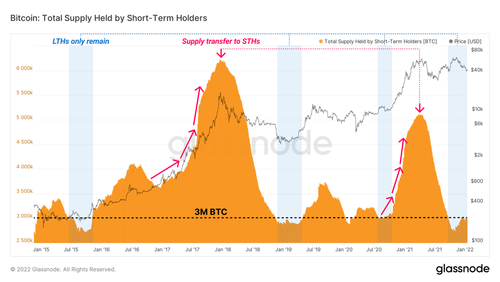

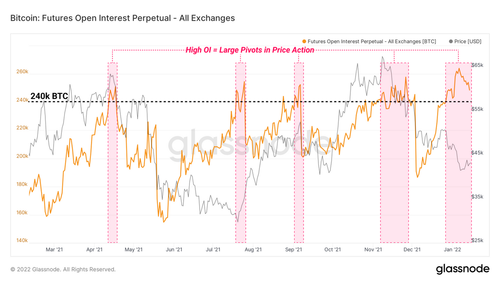
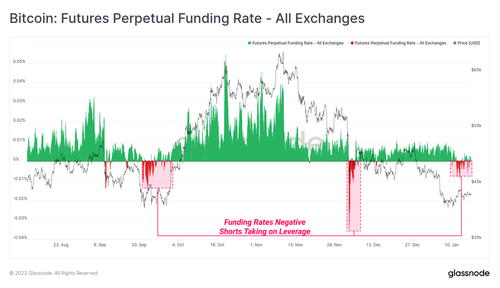
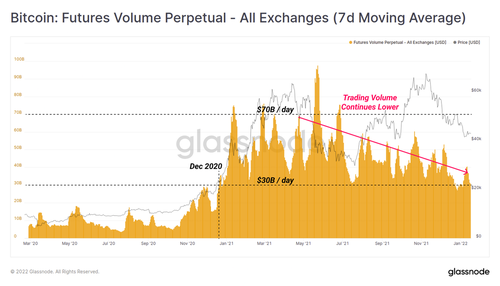
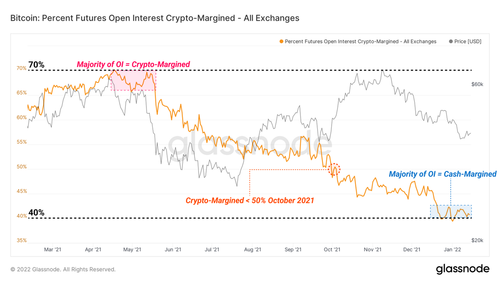


0 comments
Post a Comment